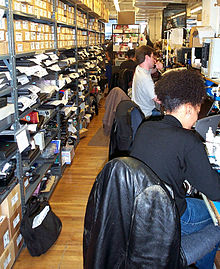- Computer repair technician
-
A computer repair technician is a person who repairs and maintains computers and servers. The technician's responsibilities may extend to include building or configuring new hardware, installing and updating software packages, and creating and maintaining computer networks. Computer repair technicians work in a variety of settings, encompassing both the public and private sectors. Because of the relatively brief existence of the profession, institutions offer certificate and degree programs designed to prepare new technicians, but computer repairs are frequently performed by experienced and certified technicians who have little formal training in the field.[1]
A repair technician might work in a corporate information technology department, a central service center, or a retail computer sales environment. A public sector technician might work in the military, national security or law enforcement communities, health or public safety field, or an educational institution. Despite the vast variety of work environments, all computer technicians perform similar physical and investigative processes, including technical support. Experienced technicians might specialize in fields such as data recovery, system administration, or information systems. Some technicians are self-employed or own a firm that provides services in a regional area. Some are subcontracted as freelancers or consultants. This type of technician ranges from hobbyists and enthusiasts that volunteer or make a little side money, to those who work professionally in the field.
The repair of problems can range from a minor setting that is incorrect, to spyware, viruses, and as far as replacing hardware or an entire operating system. Some technicians provide on-site services usually at an hourly rate. Others can provide services off-site, where the client can drop off at the repair shop. Some have pickup and drop off services for convenience. Some may also take back old equipment for recycling (In the EU, this is required under WEEE rules).
Contents
Hardware repair
While computer hardware configuration varies widely, a technician will work with five general categories of hardware; desktop computers, laptops, servers, computer clusters and smartphones / mobile computing. Technicians also work with and occasionally repair a range of peripherals, including input devices (like keyboards, mice, and scanners), output devices (like displays, printers, and speakers), and data storage devices such as internal and external hard drives and disk arrays. Technicians involved in system administration might also work with networking hardware, including routers, switches, fiber optics, and wireless networks.
Software repair
When possible, repair technicians protect the computer user's data and settings, so that after repair, the user will not have lost any data and the technician can fully use the device with little interruption, and then diagnose the problem. Addressing the issue, the technician could take action as minor as adjusting one or several settings or preferences, but could also apply more involved techniques like installing, uninstalling, or reinstalling various software packages. A reliable, but somewhat more complicated, procedure for addressing software issues is known as a restore, in which the computer's original installation image (including operating system and original applications) is reapplied to a formatted hard drive. It should be known though, that anything unique, such as settings, or personal files will be destroyed if not backed up on external media, as this reverts everything back to its original unused state.
See also
Notes
- ^ Computer Support Specialists and Systems Administrators, Bureau of Labor Statistics, U.S. Department of Labor, Occupational Outlook Handbook, 2006-07 Edition, August 4, 2006.
References
- Overview of job scope
- Job description from a public school district
Categories:- Computer occupations
- People in information technology
- Technicians
Wikimedia Foundation. 2010.

